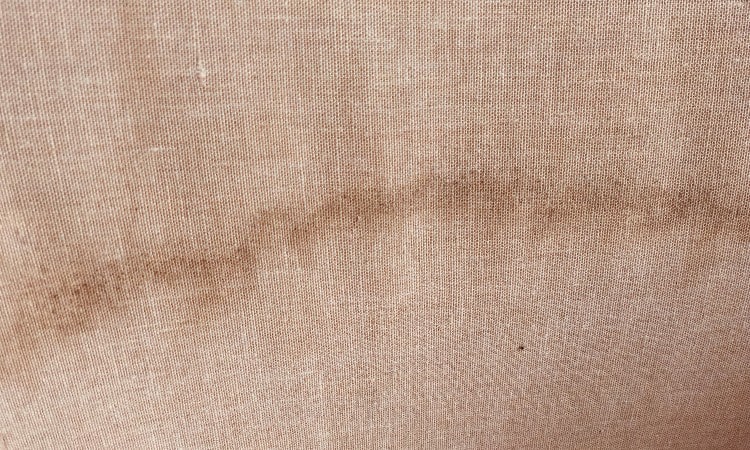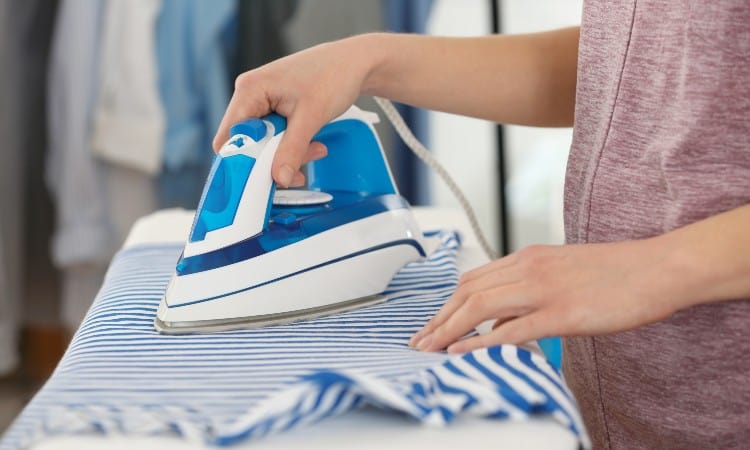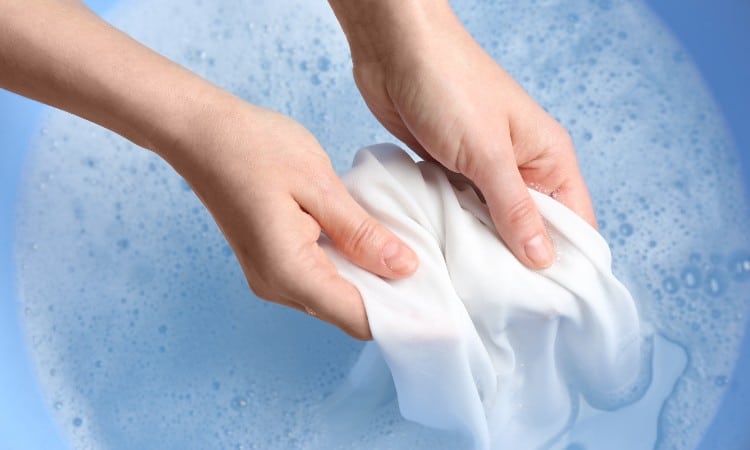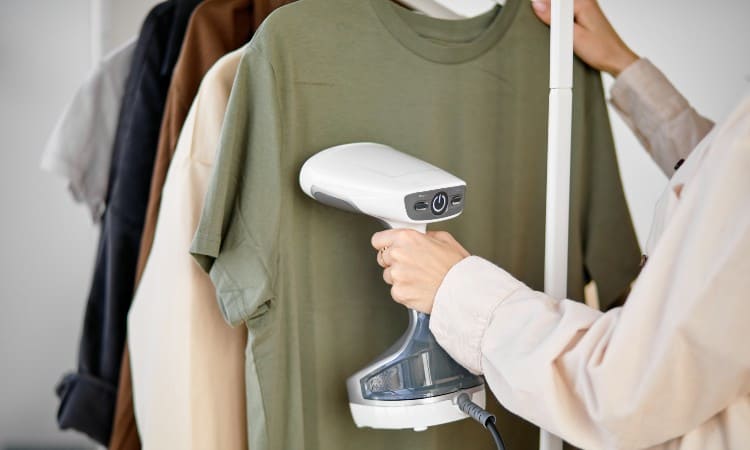Water isn’t something that you would think would stain fabric. After all, water is supposed to clean and remove stains, right? But, it can stain some fabrics just like anything else can. Luckily, water stains aren’t that hard to remove, and you can do it with things you already have at home.
Water can be removed from most fabrics by simply rewetting or rewashing the fabric. You can even use an iron to help remove water stains in some cases. But, fabrics that are stained due to something in the water may require a little more work.
In this article, I’ll explain how to remove water stains from fabric. I’ll share with you several different ways that you can remove water stains from both clothing and upholstery, as well as a couple of specific types of fabric as well.
What Causes Water Marks on Fabric?

The first step to removing water marks and stains on fabric is to recognize what caused the stain in the first place. Water can stain fabric in one of two ways. The first way is that the water may not be 100% pure (for example, if you have well water) and may contain other minerals or chemicals. This could even cause your clothing to come out of the laundry with stains, even if the stains weren’t there before.
The other much more likely way is that the fibers of a particular fabric don’t react well to water. This could cause stains to appear in areas where the water touched it, either due to rain or spills. Fabrics such as silk, satin, suede, leather, and even polyester can get water stains on them.
Most water stains on fabric will come in the form of blotches or discoloration, but again, it will depend on what type of water stained the fabric. Although discoloration could be due to the fabric not being colorfast, it often has to do with minerals such as iron in the water that can leave rust-colored stains on clothing.
Blotchy water stains usually leave behind a noticeable shape or ring where the water was, but it usually doesn’t result in discoloration of the fabric. The good news is that the water stains are not permanent in either case and be removed much easier than other stains. However, upholstery will be a little more difficult than clothing since upholstery can’t be washed in the washing machine.
How to Remove Water Stains from Fabric
The key to removing water stains effectively means knowing what type of fabric is stained and what made the stain. You don’t want to damage the fabric by using an inappropriate method or taking longer than necessary to remove the stain when there is a much simpler solution.
If you don’t know what type of fabric is stained, begin by checking the care label to make sure that it is safe to iron or put in the washing machine. These are the quickest and most effective methods to remove water stains. I’ll share with you how to do each of them below and some additional methods in case those don’t work or the stain is caused by more than just water.
1. Ironing

The ironing works for any iron-safe fabric and is just stained with water and not by chemicals or minerals found in the water. Fabrics that are safe to iron include polyester and cotton, but it’s a good idea to check the care label first before ironing any other type of fabric.
When using this method, be sure to set the iron to the appropriate temperature as indicated by the care label before turning it on. Next, place a white towel on the ironing board, turn the clothing inside out, and place it on the ironing board so the stained area is on top of the towel.
Then, dampen a washcloth and use it to re-wet the water stain. Iron over the stain until it is completely dry. The stain should be gone, but if not, then rub over the area with a spoon. The spoon will help smooth out and remove any remaining stain.
2. Rewashing

Sometimes water gets on our clothes due to spills or drips and leaves a stain, particularly on clothes made of satin or silk. If this happens, the stain can usually be removed simply by rewashing the clothing, even if the water stain is already dry.
The reason is that the whole fabric gets wet, and when it dries, the stain will no longer be there. All you’ll need to do is wash the fabric the way you normally would, then dry it using the settings that are recommended on the care label.
3. Vinegar
 Vinegar can be used to remove almost any kind of stain, and water stains are no exception. This is a great option for clothes that can’t be ironed or if you don’t have time to completely wash and dry them. But first, you’ll want to do a spot test with the vinegar to make sure that it doesn’t fade or discolor the clothing.
Vinegar can be used to remove almost any kind of stain, and water stains are no exception. This is a great option for clothes that can’t be ironed or if you don’t have time to completely wash and dry them. But first, you’ll want to do a spot test with the vinegar to make sure that it doesn’t fade or discolor the clothing.
To do a spot test, pour a little vinegar onto a cotton ball, then dab it onto a hidden place on the fabric, such as the inside seam or near the collar. Wait about 5 to 10 minutes to check for discoloration or stains. If the vinegar is safe to use, then follow the steps below.
First, you’ll want to dampen a washcloth with vinegar and re-wet the stained area of the fabric. Next, dampen just the corner of another washcloth with vinegar and rub the cloth over the stained area to remove the spot. Then, re-wet the first washcloth if necessary, wring it out, and rub it over the stained area again to remove the vinegar. Then let the area dry completely and repeat the process if necessary.
4. Steam

If you have a handheld steamer, you can quickly remove water stains from fabric. This is another great method to use if you are in a hurry. Just blast the stained area with steam and let it dry.
If you don’t have a handheld steamer, you can also use your iron if it has a steam function. However, you’ll want to first make sure that the iron only emits steam and not water since water could create more stains on certain fabrics. If you use an iron, follow the same procedure as using a handheld steamer and let the fabric dry.
5. Rust Remover
If fabric has a colored water stain or streaks of brown, yellow, or orange, this could be due to iron or other minerals in the water. This is especially common if you live in a rural area that uses well water and it can even happen while your clothes are washing.
If you notice this type of water stain on your clothing, you can remove it with a laundry product specifically designed for rust removal. This type of product usually comes in the form of a laundry detergent and you use it the same way as you would your regular detergent. Just be sure to follow the instructions regarding how much to use.
Note that if you have well water and these stains seem to be a recurring problem, you may want to invest in a water filtration system. This will filter out any minerals in your water that are causing the discoloration so that the water will effectively serve its purpose of cleaning without staining.
How to Remove Old Water Stains From Fabric
Even if a water stain is old or dried, it can still be removed from the fabric pretty easily. But, how easy it will be to remove depends on whether the stain is just a water stain or a water stain that caused discoloration. In some cases, you may be able to remove the stain, but the discoloration will remain.
Depending on the type of stained fabric, ironing or rewashing the fabric should remove the stain pretty effectively. It’s best to use the ironing method first to remove as much of the stain as you can. It should work even if the stain is discolored.
But if, for some reason, ironing doesn’t remove all of the stain, then rewashing it should remove it the rest of the way. If the stain is discolored from minerals, go ahead and add a rust removal product into the laundry to remove the stain most effectively.
Vinegar is also very effective at removing older stains on fabric, regardless of the stain. It can also be effective at removing rust stains or discoloration from fabric due to vinegar’s powerful acidic properties. Remember to do a spot test of the vinegar on the fabric first.
How to Get Rid of Water Stains on Fabric Car Seats
Our car seats are another area that is susceptible to water stains, either due to us leaving our windows when it rains or spilling a drink in our car. Polyester is a common material used to make car seats, and removing water stains from polyester is very easy to do.
The problem with removing water stains from fabric car seats is that the fabric can’t be removed, so your options are limited as to how you can clean them. With that being said, you will have to spot treat the stain.
It’s a good idea to first start by vacuuming the car seat to remove any dirt or grime that could potentially stain the seat if it gets wet while trying to clean it. You can use a handheld vacuum or shop vac, but at the very least, wipe off the seat before removing the stain to remove any loose dirt or debris.
Next, create a mixture of one gallon of warm water, one cup of vinegar, and a squirt of dish soap in a tub or container. Mix them so that they are evenly dispersed, then dip a microfiber cloth or small scrub brush into the solution.
Use the cloth or brush to thoroughly wet and scrub the area to remove the stain. Then, wet another cloth with just water and rinse out the soap and vinegar. Let the stain dry, then repeat the process if necessary. You can roll down the windows to lessen the drying time as long as it doesn’t rain.
If the stain remains after the seat dries, you may have to repeat the process or move on to a stronger product, such as a spray cleaner made specifically for fabric car seat upholstery. If the stain is really large or has been there for a while, you can also skip straight to the car upholstery cleaner.
How to Get Water Stains Out of Polyester
As long as the water stain is on polyester clothing or another washable polyester fabric that can be ironed, you should be able to remove the stain just by using the ironing method above. What’s important to remember, however, is that polyester is a synthetic fabric, so it can melt or become damaged when exposed to temperatures that are too hot for the fabric to handle.
When ironing polyester, set your iron to either a medium temperature setting (between 110 and 150℉) or a setting that is specifically for synthetic fibers. This will help ensure that the fabric doesn’t become damaged when ironing it.
Once you’ve made sure that the iron is set to the right temperature, turn the polyester fabric inside out if applicable and place it on the ironing board on top of a clean white towel. Wet the stain with a damp washcloth, then iron over it until it is dry. The towel underneath will help to absorb some of the stain.
If the area dries and the stain is still there, you can repeat the process above, wash the fabric, or use the vinegar method described above. If it’s a rust-colored water stain, you can try using a laundry rust removal product instead.
How to Remove Water Stain From Silk
Silk is one of the fabrics that is most likely to show water stains and the best way to get the water stains out is to wash the fabric. Since silk is a delicate fabric, it is recommended that the fabric be hand-washed instead of washed in the washing machine.
With that being said, to remove water stains from silk, you’ll first need to fill a bucket or washtub with lukewarm water and a small amount of delicate detergent. It’s very important to use a detergent designed for delicates because even mild detergents can be too harsh for some delicate fabrics.
Place the silk fabric into the water and let it soak for no more than 5 minutes. Soaking silk for longer than that can damage the fabric or cause the colors to run. After removing the silk from the water, rinse the soapy water and refill the bucket with clean lukewarm water.
Run the silk fabric through the clean water to remove the soap. Continue this process until you feel as if all the soap has been removed. Let the fabric dry by laying it flat on a clean towel. Check the fabric in about an hour to make sure the stain has been removed and repeat the process if necessary.
How to Get Water Stains Out of Upholstery Fabric
Sofas, couches, and chairs are other common areas that can become stained due to water spills. As with car seats, upholstery isn’t hard to remove water stains from, especially if the upholstery is made from polyester. But the problem is that you can’t remove it to wash it.
For most upholstery fabrics, steam cleaning works well. You can use a handheld steamer or rent a larger steam cleaner, just depending on how big the stain is. The downside to this is that you have to wait on the upholstery to dry afterward, taking a long time for certain fabrics.
You can also spot clean the stain if only a small area needs to be cleaned. To do this, create a mixture of one gallon water to one cup of vinegar, and add in a small squirt of dish soap.
Dip a microfiber cloth in the mixture and rub it across the stained area to clean it. Then, dampen another cloth with clean water and use it to rinse off the water and vinegar. Once the area has been rinsed, you’ll have to wait on it to dry to see if the stain has been removed.
This can take a long time and you won’t be able to sit on that area of the furniture while it dries. Turn on your ceiling fan or a small electric fan or use a hairdryer set on a cool temperature setting to speed up drying time.
Conclusion
I hope you found this guide helpful for removing water stains from clothing and upholstery fabric. In most cases, water stains are easy to remove simply by re-wetting the fabric and letting it dry. But if the stain is discolored, you may need to use vinegar or a rust removal laundry product to remove the stain. If you enjoyed this article, share it with others and leave a comment. Thanks for reading!